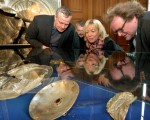 An unnamed and unauthorized metal detectorist found a late Roman gold and silver hoard in the forest near Ruelzheim in Germany’s southwestern Rhineland-Palatinate state and dug it up so he could sell it on the black market. The authorities are not releasing specifics on how this scofflaw was discovered hoarding an ancient hoard except to note that “the looter rendered up [the pieces] himself – but only under pressure from investigators.” That means they caught him first and persuaded him to surrender the loot. The police have reason to believe he may have already succeeded in selling some of the pieces overseas. They will continue to investigate the case, looking for missing artifacts. No announcement was made regarding whether the looter would be charged with any crimes.
An unnamed and unauthorized metal detectorist found a late Roman gold and silver hoard in the forest near Ruelzheim in Germany’s southwestern Rhineland-Palatinate state and dug it up so he could sell it on the black market. The authorities are not releasing specifics on how this scofflaw was discovered hoarding an ancient hoard except to note that “the looter rendered up [the pieces] himself – but only under pressure from investigators.” That means they caught him first and persuaded him to surrender the loot. The police have reason to believe he may have already succeeded in selling some of the pieces overseas. They will continue to investigate the case, looking for missing artifacts. No announcement was made regarding whether the looter would be charged with any crimes.
 By German law, all excavations for archaeological material must be authorized in advance by the government heritage authority. Different states have differing laws on the particulars. Some allow finders to keep half the value of a find, if not the find itself. The Rhineland-Palatinate is not one of them. Searching for ancient artifacts with a metal detector is a misdemeanor offence. Removing any artifacts discovered without reporting them rises to the level of fraud, and selling them can result in a charge of receiving stolen property.
By German law, all excavations for archaeological material must be authorized in advance by the government heritage authority. Different states have differing laws on the particulars. Some allow finders to keep half the value of a find, if not the find itself. The Rhineland-Palatinate is not one of them. Searching for ancient artifacts with a metal detector is a misdemeanor offence. Removing any artifacts discovered without reporting them rises to the level of fraud, and selling them can result in a charge of receiving stolen property.
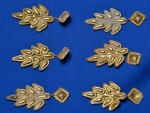 Certainly if monetary value plays a part in determining the severity of a property crime in Germany as it does in the US, this looter is going to be in big trouble. The hoard includes three dozen beautifully detailed solid gold brooches shaped like leaves, even more gold square pyramids that archaeologists believe all once ornamented a ceremonial tunic of an important Roman official. There’s also a silver dish with the remains of gilding still visible that was cut into pieces, possibly to be used as hacksilver, a solid silver bowl with gold accents inset with semi-precious stones, a crumpled and folded highly decorated silver plate that may have been a chest cover. A set of silver and gold statuettes and pieces of fittings are the remarkable survivors of what was once a curule seat, a commander’s portable folding chair.
Certainly if monetary value plays a part in determining the severity of a property crime in Germany as it does in the US, this looter is going to be in big trouble. The hoard includes three dozen beautifully detailed solid gold brooches shaped like leaves, even more gold square pyramids that archaeologists believe all once ornamented a ceremonial tunic of an important Roman official. There’s also a silver dish with the remains of gilding still visible that was cut into pieces, possibly to be used as hacksilver, a solid silver bowl with gold accents inset with semi-precious stones, a crumpled and folded highly decorated silver plate that may have been a chest cover. A set of silver and gold statuettes and pieces of fittings are the remarkable survivors of what was once a curule seat, a commander’s portable folding chair.
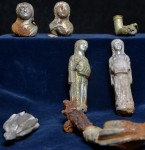 The hoard dates to the early part of the fifth century A.D., a time when Germanic tribes banged away at each other and at the weakening Roman Empire. The Battle of Mainz took place in 406 A.D. not far from where this treasure was buried and it was a watershed event in the collapse of Roman control of Europe. Pressured by Huns in the east, migrating allied tribes including Alans, Suevi and Vandals assembled on the east bank of the Rhine. The Franks sent a raiding party across the river and succeeded in killing the Vandal king Godigisel, but the Alans turned the tide and defeated the Franks. The tribes then crossed the Rhine into Gaul on December 31st,
The hoard dates to the early part of the fifth century A.D., a time when Germanic tribes banged away at each other and at the weakening Roman Empire. The Battle of Mainz took place in 406 A.D. not far from where this treasure was buried and it was a watershed event in the collapse of Roman control of Europe. Pressured by Huns in the east, migrating allied tribes including Alans, Suevi and Vandals assembled on the east bank of the Rhine. The Franks sent a raiding party across the river and succeeded in killing the Vandal king Godigisel, but the Alans turned the tide and defeated the Franks. The tribes then crossed the Rhine into Gaul on December 31st, 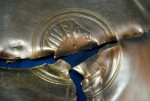 406, breaching what had been for centuries one of Rome’s strongest boundaries and pillaging Mainz, Rheims, Amiens and Strasbourg among many other Roman cities. It marked the end of Roman political and military control in northern Gaul and ushered in the Migration Period.
406, breaching what had been for centuries one of Rome’s strongest boundaries and pillaging Mainz, Rheims, Amiens and Strasbourg among many other Roman cities. It marked the end of Roman political and military control in northern Gaul and ushered in the Migration Period.
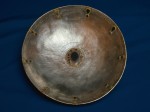 It’s no wonder why someone might have sought to bury his most precious treasures under these circumstances. The jewels from ceremonial clothing, the elaborate silver and gold folding chair and the exquisite silver tableware all point to them having been the belongings of an important magistrate or even royalty. These were the highly recognizable attributes of Roman political authority. They were buried near a former Roman road, whether by its original owner of by marauders who wanted to keep it safe from competing marauders, in a relatively shallow hole. It’s a testament to how dangerous the roads were that nobody made it back to reclaim so vast a treasure.
It’s no wonder why someone might have sought to bury his most precious treasures under these circumstances. The jewels from ceremonial clothing, the elaborate silver and gold folding chair and the exquisite silver tableware all point to them having been the belongings of an important magistrate or even royalty. These were the highly recognizable attributes of Roman political authority. They were buried near a former Roman road, whether by its original owner of by marauders who wanted to keep it safe from competing marauders, in a relatively shallow hole. It’s a testament to how dangerous the roads were that nobody made it back to reclaim so vast a treasure.
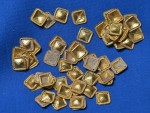 The age and nature of this hoard makes it a unique find in Germany, worth at least a million euro on the market and worth far more than that in historical value. It would be worth inestimably more if it had been excavated with respect for its context. Instead, the looter pulled whatever he could out of the ground, having no care whatsoever for archaeological integrity. According to state archaeologist Axel von Berg, the curule chair, for example, was “brutally torn out of the earth and destroyed.” The site itself was deliberately damaged. Boy would I love to see this thief prosecuted just for doing that.
The age and nature of this hoard makes it a unique find in Germany, worth at least a million euro on the market and worth far more than that in historical value. It would be worth inestimably more if it had been excavated with respect for its context. Instead, the looter pulled whatever he could out of the ground, having no care whatsoever for archaeological integrity. According to state archaeologist Axel von Berg, the curule chair, for example, was “brutally torn out of the earth and destroyed.” The site itself was deliberately damaged. Boy would I love to see this thief prosecuted just for doing that.
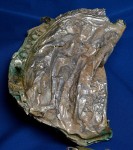 Meanwhile, some people are getting excited over the prospect that this could be part of the legendary Nibelung hoard, the Rhine gold that features in Norse and German sagas and Richard Wagner’s opera cycle based upon them. The evidence for this is nonexistent, of course. The fifth century dating and the location somewhere in the vague area where the Rhine may have once flowed but doesn’t any longer is all it took for the legend buzz to start.
Meanwhile, some people are getting excited over the prospect that this could be part of the legendary Nibelung hoard, the Rhine gold that features in Norse and German sagas and Richard Wagner’s opera cycle based upon them. The evidence for this is nonexistent, of course. The fifth century dating and the location somewhere in the vague area where the Rhine may have once flowed but doesn’t any longer is all it took for the legend buzz to start.
The treasure will soon go on display in Mainz and Speyer.
Livius,
Any thoughts as to why the silver bowl is open at the base?
I agree with Peter and Link that it’s not a hole but a dark stone of some kind, possibly obsidian or agate.
The re-looted bowl open at the base ? Which one ? – The black thing at the base of the intact bowl seems to be some sort of inlay, whereas the two pieces of gold, one of them open at the base, seem to be metal fittings. The mindset of the original looters was probably not totally different from that of their modern counterparts. All what counted was the scrap metal value, and before the crossing everything was cut to pieces and distributed. From what I remember there might have been bigger gallo-roman hoards east of the rhine, but I might be wrong.
I don’t believe it is a hole. It appears to be a jewel.
:skull:
That’s me. I am ded. All them broaches have killed me.
Because they’re super pretty and you wish them to adorn your ceremonial robes?
Gorgeous though they are, the leaves look like they would be sewn on through the pyramids, not attached via the leaves, allowing the leaves to dangle. unless there’s an image if the back of one with a pin I didn’t see?
The destruction that accompanied the looting is appalling. In addition to the loss of the chair, which I assume would have been unique for its date, careful excavation of the garment ornaments would probably have revealed the patterns in which they were sewn on the long-decayed robe.
Have you seen the Greek bronze Apollo fished-up of Gaza? http://www.bbc.co.uk/news/magazine-26275578
The Romans, being a superstitious lot, could have been using the bowl for water scrying. Getting advice from the gods, as it were.
I would use them on my cloak.
I would use them on my ears.
I would use them in my hair.
I would use them everywhere.
That hoard from the early fifth century follows indeed a certain pattern. The dioceses on both sides of the Rhine, however, seem to be in fact much older than my humble self would have imagined them to be: The bishopric of Strasbourg was founded before 343, whereas the one of Speyer is said to have been founded in the 3rd or maybe 4th century, and it seems as if by 346 there was a bishop based in Worms. As this list is indicating, crisis was on the other hand immanent. With reference to the ‘Crossing of the Rhine’ in 405/6, this list of magistri militum per Gallias features some interesting characters. In 476, the battle of Ravenna, for the time being, ended twelve-hundred years of constant ‘Roman’ rule in Italy. Over more or less 5 centuries, quite a lot could have been looted, and certainly was.
Oh my! What I would not give to have had these professionally excavated and a few textile fibers attached to those wee pretty leaves. I want to now how and where they were attached and to what kind of garment.
I just read about this here and had to research more about it. Could you imagine if it is the Nibelung treasure – how amazing!
The dangling leaves look a lot more like the 15th century mental mounts seen on the sleeves of houppelandes and other clothing in Europe, than on things earlier (but I don’t know a lot about much earlier styles of dress.) Are the authorities certain that they are from the same strata as the Roman artifacts recovered?
I am appalled! So much was lost when some money-hungry grubber sopetarted exposing these items. I hope “they” were caught and severely reprimanded.